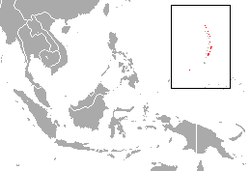| Mariana fruit bat | |
|---|---|
 | |
| Scientific classification | |
| Kingdom: | Animalia |
| Phylum: | Chordata |
| Class: | Mammalia |
| Order: | Chiroptera |
| Family: | Pteropodidae |
| Genus: | Pteropus |
| Species: | P. mariannus |
| Binomial name | |
| Pteropus mariannus Desmarest, 1822 | |
 | |
| Mariana fruit bat range | |
| Synonyms | |
Pteropus keraudrenQuoy & Gaimard, 1824 | |
The Mariana fruit bat (Pteropus mariannus), also known as the Mariana flying fox, and the fanihi in Chamorro, is a megabat found only in the Mariana Islands and Ulithi (an atoll in the Caroline Islands). [3] Habitat loss has driven it to endangered status, and it is listed as threatened by the US Fish and Wildlife Service. Poaching, habitat loss, and the introduction of invasive species have contributed to the species' decline.


